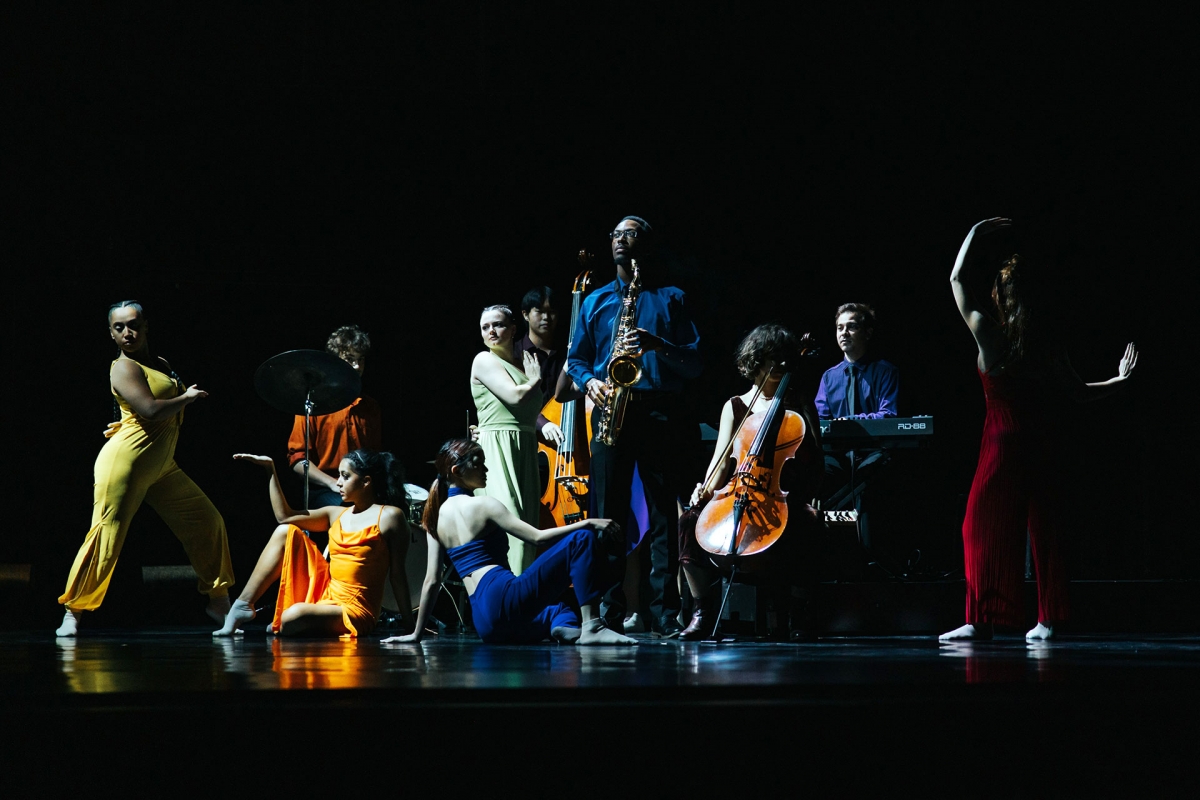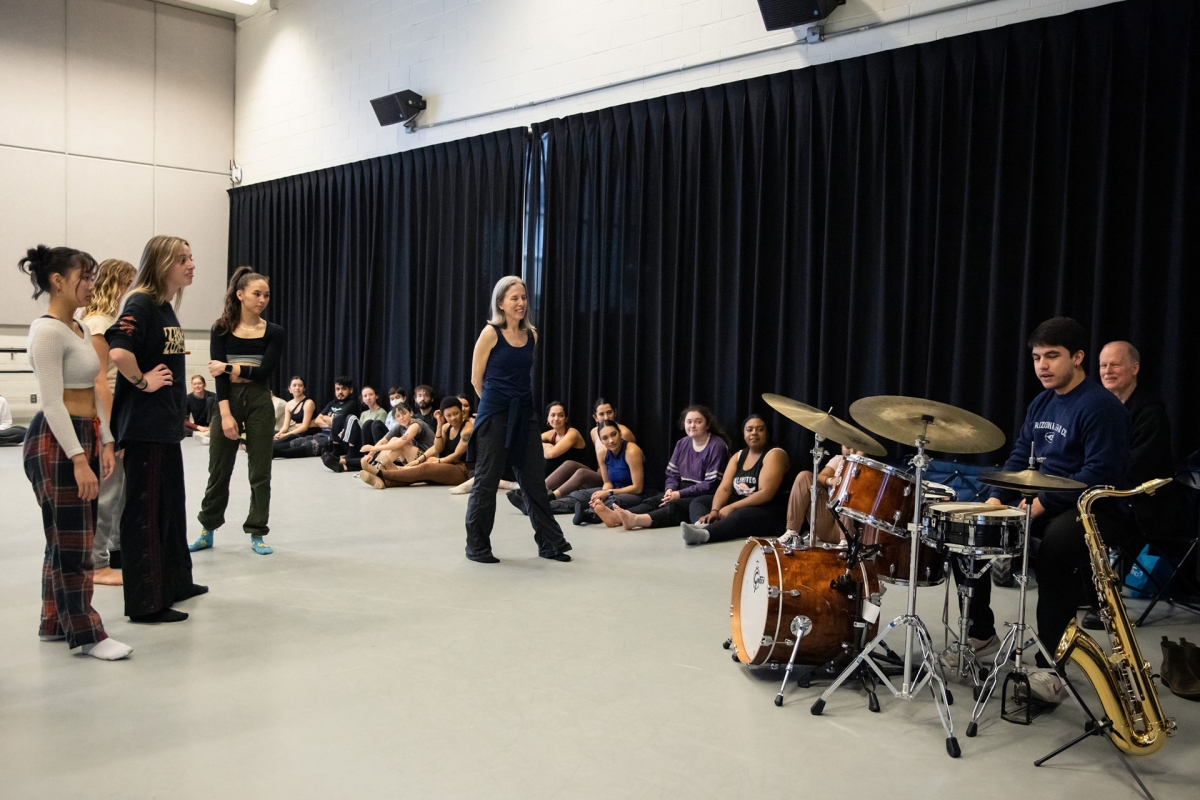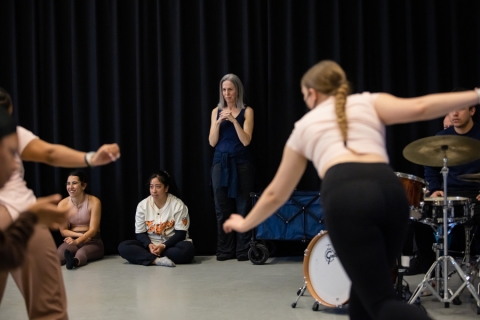Lisa Allin on Socially-Responsible Jazz Dance
By Mia Hammett
Dance teacher, retired performer, and aspiring choreographer Lisa Allin (M.F.A. Dance, ‘23) is an astute and well-intentioned practitioner of socially-responsible jazz dance. Her approach is incredibly pointed—being mindful of both the physical, embodied movements actively incorporated in her performances, and of the cultural traditions that have long informed said movements. Allin seriously engages with her work in jazz and remains staunchly historically- and socially-conscious to jazz dance as a mode of expression.
Before continuing her education in 2014, Allin worked as a freelance dancer in various commercial and concert dance productions. Her passion for dance led her to pursue an associate’s degree in dance at Irvine Valley College, where she performed with award-winning choreographer Marie de la Palme. From there, Allin was encouraged to consider dance a tool for community-building, and therefore grew increasingly involved with dance as a combined social, political, and educational pedagogy.
Historical Contexts
Informed by jazz’s 1920s-era origins—and its earlier, founding roots in Central and West African diasporic traditions—Allin very clearly engages with jazz dance in ways that recognize and honor its rich history. In doing so, she remains mindful with unabashed honesty and reserves a sort of mental space for repeated self-questioning.
“I am very well aware of the roots. I also respect that, as far as the core of jazz, I arrive at it differently than someone who is from the African diaspora—so my appreciation comes from being on a different trajectory, and I'm transparent about it. The jazz that ended up to me was appropriated and taken out of context of the value system that it came from.” Having been accustomed to a particular version of jazz—a form of jazz far-removed from its origins—Allin is interested in returning a form of contemporary jazz dance that works in conversation with its fundamental cultural contexts, and in the process developing her own practice of socially-conscious jazz.
“In order to build up that importance, we need to understand the history and the significance before considering what it was that got appropriated, and to understand the full impact of that. As an educator, and as a white person in jazz stands, it's imperative that I use this platform to bring these truths to light,” said Allin.
Since participating in her summer one-week intensive, Allin’s own approach to improvised jazz dance equally draws on Dr. S. Ama Wray’s practice of Embodiology®—a ‘movement methodology’ inspired by improvised dance and performance practices from Ghana, Africa. Embodiology® makes use of dynamic, breath-informed movement and mindful, creative engagement with the body.
“I did her seminar over the summer and it was the beginning of me learning how to improvise. I never did before; as a dancer, I was very limited in my experience of improvisation. It’s shown me how I can stay very present in the moment and make just a small move, and then I can expand that and see how that affects the rest of my body,” said Allin. She’s adapted Dr. Wray’s methodology in combination with a series of her own structured improvisations.
In addition to her creative practice, Allin’s found that, “in life, it’s tuning me more acutely into the moment, and drawing on my senses in a way where I can now choreograph, write a paper, or go about my daily life with this same sensibility—where I'm drawing not just on my cognitive ability, but my intuitive, physical, and emotional ability,” said Allin.

Image: Lisa Allin's piece "The Jazz Treatment" from New Slate 2022 in the Claire Trevor Theatre. (Photo: Sam Zauscher)
Dance as Her Chosen Medium
While dance is Allin’s creative medium of choice, she’s deeply moved by the artistic elements that have traditionally informed both mediums of dance and music—rhythms, movements, and gestures—and their corresponding cognitive and physical sensations.
“It's the music, and the somatic experience of that music, pulsing through my body and expressing itself in rhythmic harmony. As a former singer, feeling it through my lungs and vocal cords is also very powerful, along with being in a body of people moving, singing, and dancing all at the same time,” said Allin. But it’s the element of physicality, the body as a creating force, that ultimately tips the medium of dance in her favor. She values dance’s ability to infinitely generate and create no two identical movements or elements of motion.
On improvised dance in particular, she described how “it's very liberating because it's never going to be the same again. You can't be attached to it, you can't own it, you can't colonize it. But then there'll be something else rich in the next incarnation.
“I think I tend to do a lot of ball-change steps, which seems to be influenced by a foundational step in West African dance. When I studied a documentary of West African dance, I noticed a step in some of their dances that looks like the ball-change, and I feel like I know that step. I’m starting there and kind of drawing on my tap vocabulary for some of the footwork, and allowing that to generate an impulse that informs the rest of my body.”
For Allin, much of improvised dance is an exercise in mindfulness. It’s her way of externalizing the internal, of growing very attuned to subtle gestures, experiences, and motions of the body and the mind—a sort of syncopated musicality. “When we say mindfulness, it's not privileging the mind over the body or the spirit. It's everything at once. As I learned from Dr. Wray’s workshop, it’s feeling from the inside out: an impulse that comes from the inside. It goes through a motion; it goes through physicality; it goes through thought. Ihe Anlo-Ewe speaking people of Southeastern Ghana would call this seselelame, meaning feel, from the flesh inside,” said Allin.
Jazz as Social Inclusion
Allin believes wholeheartedly in dance being as much a unifying social practice as a creative medium. She’s interested in how dance can serve the community, and sees jazz dance as a form of social unity—a form of social inclusion regardless of race, gender, or belief.
This idea of community, social uniformity, and collectivity informs Allin’s approach to choreographing her dancers. She believes jazz dance can even counter some of the effects of ideological separation, of polarization, of radical differences in opinion.
“I would like to facilitate public platforms for regular jam sessions. I picture myself gathering musicians and dancers into accessible spaces where people already mingle, like a weekly farmer’s market. It's a great public space where people go, and there's no political or religious expectations—a secular space. I thought I could intercept these public gatherings with some jazz music that's strategically located. We need to have spaces where we have the words, but I think we also need spaces where we can be our bodies moving together without language. I think we'll move faster into harmony—then, hopefully, the language will follow,” said Allin.
The Jazz Treatment
“The Jazz Treatment”—an extension of Allin’s thesis—consists of structured, live improvisations between dancers and musicians, where both share the stage. Her next work premieres at Dance Escape, 2023, and will feature a 15-minute piece as part of her final thesis presentation.

Images (top and above): Lisa Allin teaches at the 2023 American College Dance Association's Baja Conference (ACDA) at the Claire Trevor School of the Arts. (Photo: Skye Schmidt)
Watch Lisa Allin's thesis piece during Dance Escape 2023, the M.F.A. graduate student showcase, April 20-22, 2023. To purchase tickets, visit dance.arts.uci.edu/tickets.
Please visit our secure direct giving page and make a gift to support Dance today!

